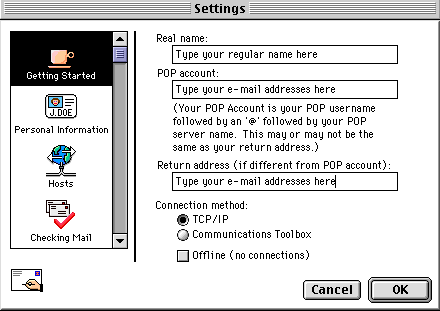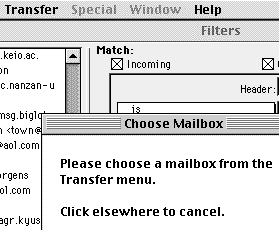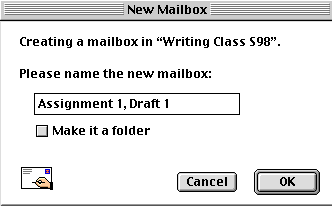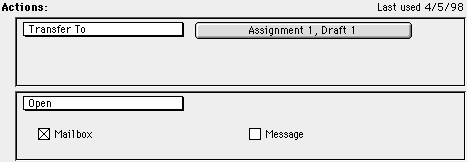Let the E-mail Software Do the Work: Time Saving Features for the Writing Teacher
Ron Belisle
ronb [at] mfwi.org
Mukogawa Fort Wright Institute, Spokane, Washington USA
Part I of this two-part article examines two very useful features of most up-to-date e-mail software programs that can save the writing teacher time organizing, filing, retrieving, and responding to student e-mail writing assignments. Part II details a step-by-step process for downloading off the Internet a freeware e-mail software program (Eudora Light), installing it up on your computer (Mac or Windows), and helping you set-up some of these time-saving features.
Part 1 - The Problem and the Solution
In 1997 I taught 2 university writing classes in Japan of 25 students each. During the 12-week term I assigned 6 e-mail writing assignments to each student, some of which required 3 drafts each. The total, 50 students x 6 assignments x 3 drafts, of 900 individual pieces of correspondence, (plus my responses and feedback), was not as overwhelming as you may think.
I let the software do much of the work for me by using two important but not so commonly used features called Filtering and Stationary. (Both Eudora Pro (http://www.eudora.com) and Microsoft Exchange (http://www.microsoft.com/exchange) include these features, but many other software packages also have them. Please note that some software programs use different words for the same features.) By doing so, I was able to devout more of my time on the actual teaching of writing.
Filtering is the most important time-saving feature. Messages can be automatically sorted, organized, and replied to depending on certain teacher-defined criteria. For example, suppose a teacher wants to track which students have e-mailed the first draft of the first assignment and which have not. By setting up certain filtering criteria, the software will automatically organize and sort all the incoming (and outgoing) mail related to that assignment into a teacher-defined mailbox. That criteria can be anything. For example, by telling students the e-mail subject of the first assignment should be "Assignment 1, Draft 1", the software will automatically filter all the messages which contain (or is) this subject into the mailbox that the teacher sets up beforehand. The teacher can then scroll up and down this mailbox which lists the names of all the students who have completed that assignment. (The list will include no other subject or topic, only that assignment.) In addition, a filter will not only put the assignment into an assignment mailbox, but also it can put a copy into a student mailbox. By doing so, a teacher has a mailbox of both the assignment (which is useful for knowing who has finished and who has not) and a mailbox for each student (which is useful for knowing which assignments a particular student has completed).
Another useful feature of e-mail software is called Stationary. (This is not available in the freeware version of Eudora Light.) Stationary allows the teacher to create predesigned, teacher authored messages which can be used again and again without having to recreate them. These messages can work with a filter and be automatically sent back to the student as automated replies. A message can be automatically sent, for example, when a particular assignment is received from a student. This response lets the student know that the teacher has successfully received the assignment and will get back to him or her later.
Automated Stationary responses can be helpful because many times students are concerned whether or not the teacher has received a particular assignment. In my case by creating an automatic "Received successfully" reply, there were 900 fewer replies to write during the course of the term.
Writing teachers have a lot of work to do to help students improve their writing. Sometimes other time-consuming things like organizing, filing, retrieving and replying to a student's writing can take away important time from teaching. If you are using e-mail in your writing class, the use of Filtering and Stationary can be a big help and save you a lot of time for more important things, like the actual teaching of writing.
Part II - Downloading Eudora Light, Setting It Up, and Creating a Filter
This part details a step-by-step process of downloading* off the Internet a free copy of Eudora Light (Windows or Mac) and setting it up on your computer. It also includes clear step-by-step instructions on how to set up a filter for use in your writing class and (Windows** or Mac) to start you on some of these time-saving features.
*Always check with your network administrator before downloading software, especially network software such as Eudora Light. There may be some network restrictions.
**The screen shots used below are from a Macintosh. There will be a slight difference if you are using Windows, however the basic commands are all the same, only the position and appearance differ.
Step 1 (Windows or Mac) - Downloading Eudora Light from the Internet
Visit this site below. I suggest that you open a new window in your browser, so you can have this window, plus the new window open at the same time. (Mac users: Hold down the mouse button while clicking on the link below and then pull down to the appropriate command . Windows users: Click the right mouse button while clicking on the link below and then pull down to the appropriate command.)
http://eudora.qualcomm.com/eudora light/
Click on the "Download Eudora Light" link. Choose your platform (Windows or Mac) and click on the "Email Client Software" link to download the software to your computer.
(International versions of the software are also available on this page. You may want to bookmark it for future reference.)
Step 2 (Mac only) - Unstuffing the downloaded file.
Unstuff the compressed file titled "epl313". Follow the instructions on the screen. Restart your computer if prompted.
Step 3 - Setting up Eudora for the first time. (Mac or Windows)
Open the Eudora Light folder and then the Eudora Light application. Type the following information into the 3 fields (boxes) below.

Click OK.
Eudora is now set and ready for use to send/receive Internet e-mail.
If you are not familiar with the standard send/receive e-mail commands, you should practice using these as well as using and understanding the Address book under the Special menu.
STEP 4 - Setting up your first filter. (Mac or Windows)
Open the Eudora Light application.
Choose Filters under the Special Menu.
Click on the New button in the bottom left.
Set up your filter exactly as I have done below. The three boxes should be checked. Also, the two pull-down menu items should be set as I have done and the exact words "Assignment 1, Draft 1" should be typed in the field as seen below.

Eudora can now perform certain actions based on the criteria you have defined above.
Step 5 - Setting up the assignment mail box (Mac or Windows)
Pull down the first pull-down menu under the word "Actions" to "Transfer". Currently, the word "None" is shown because no actions have been set up yet.

At this point Eudora will ask you to choose a mailbox, however, you need to create a new mailbox for your project first. Do that under the Transfer menu by pulling down to "New..."
Then you will see this window.

Complete the information as I have done above. Check the box so this is a folder. This means that your writing class will have many different assignments and each assignment will have it's own folder within the "Writing Class S98" folder.
Click OK.
Then you will see another similar window like this. Type in the name of the writing assignment as I have done. Don't choose the "Make it a Folder" option.

Click OK
Now Eudora will automatically put all e-mail messages titled "Assignment 1, Draft 1" into this mailbox.
Step 6- Setting up a second filter (Mac or Windows)
A second Action that I like to set up will open the mailbox for this assignment each time you receive mail with that subject..
Pull down to Open in the pull-down window.
Check on the Mailbox square as I have done below.

Now Eudora will open the mailbox for this assignment each time you receive mail with that subject.
Good job. Your first filter is set up.
Before you close the Filters window, look closely at the different options in the "Header" pull-down menu and the other pull-down windows under the word Incoming". Notice that Filters can do many things and are very flexible. (If you have a Macintosh, turn on Balloon Help. Eudora has good explanations of each of the features in the Filter window.) Filters can also put a copy of a project into a mailbox for a student. They can also automatically send copies of certain mail to supervisors and/or colleagues. The options can be very time-saving.
Close the filter window. If it prompts you for a save, do so.
To test your filter, you can send a message to yourself with the subject as Assignment 1, Draft 1
If you prefer, you can send the same message to me at ronb [at] mfwi.spokane.cc.wa.us.
My Microsoft Exchange e-mail account is set up 24 hours a day, 365 days a year to respond to letters with this as the exact subject.
Good luck and please send your questions, comments and advice to me at rbelisle [at] ior.com with Comments, Questions, Advice as the subject of your message
The Internet TESL Journal, Vol. IV, No. 4, April 1998
http://iteslj.org/